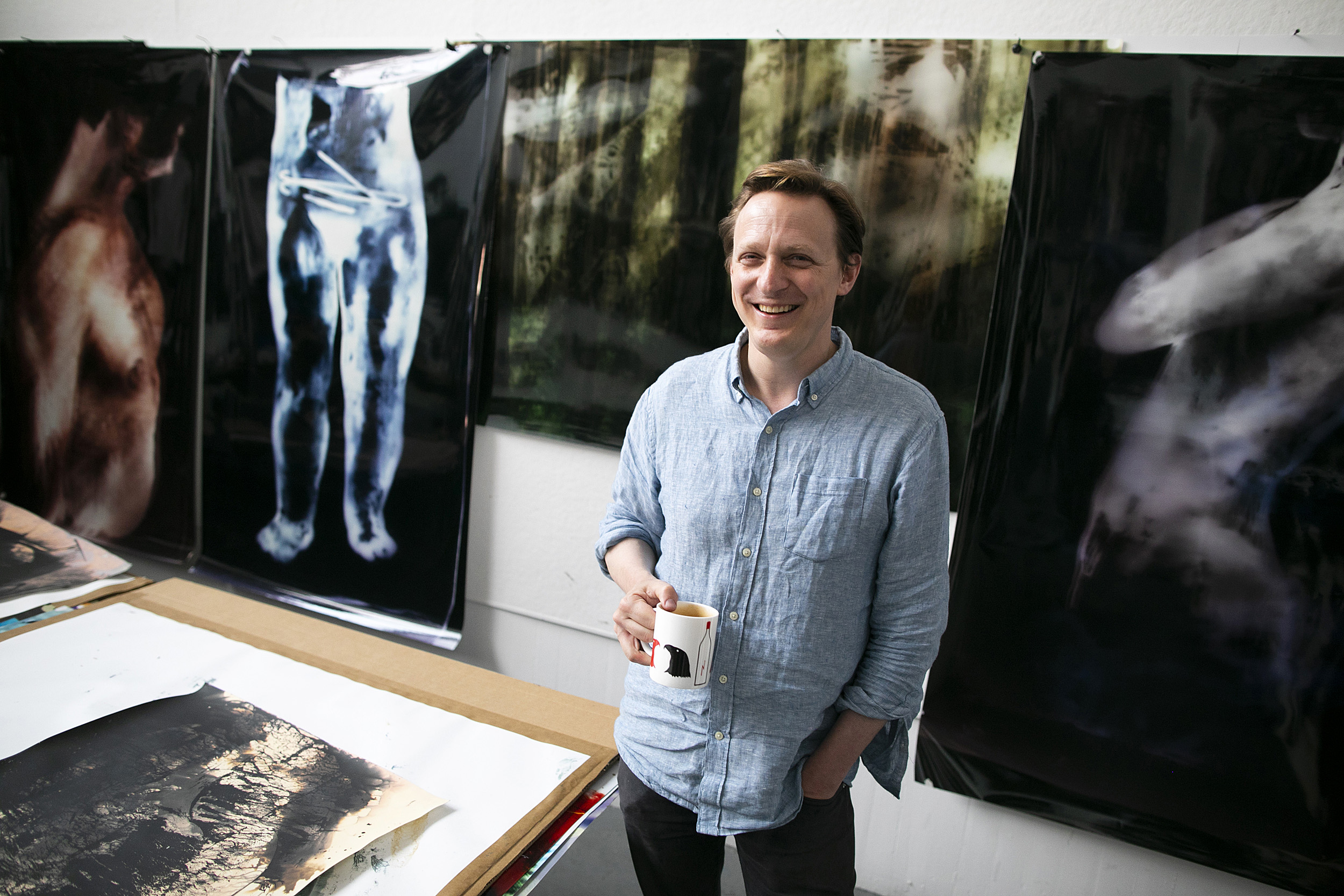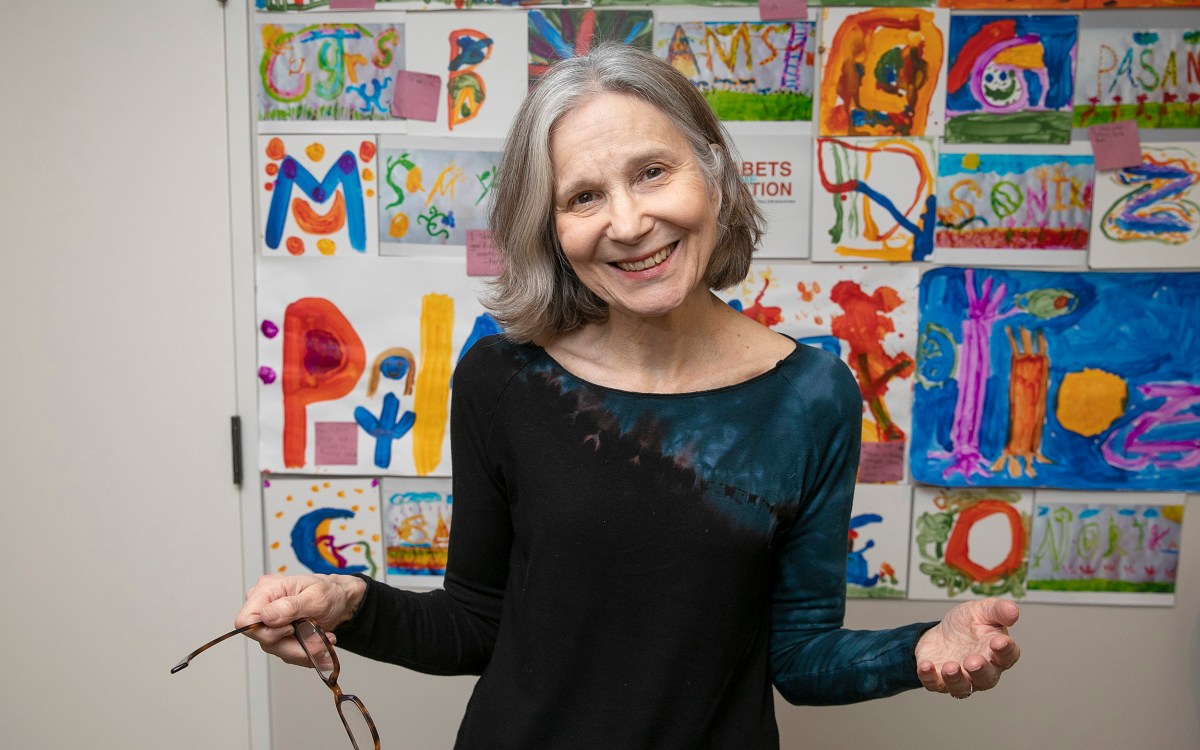
Matt Saunders’ recent work combines printmaking and photo-developing techniques.
Stephanie Mitchell/Harvard Staff Photographer
Photography without a camera
Matt Saunders explores art through unorthodox methods
When Matt Saunders talks about his art, he could be describing his life.
“I try to avoid rote ways of working, and find ways to do things that allow for a kind of blindness about what a process may yield,” says Saunders, the Harris K. Weston Associate Professor of the Humanities. “It allows me to see something differently than I might be accustomed to.”
As a teacher Saunders, the incoming director of undergraduate studies in the Department of Art, Film, and Visual Studies (AFVS), will collaborate on a fall course on printmaking with an art historian. And in spring he is preparing to offer a new Gen Ed course in painting that will require him to find ways to introduce large groups of students, most of whom are not studying art, to “a language outside of words,” as the course description puts it.
As an artist, the hazy, lazy days have been few this year.
“For the past few years, I’ve been staying in Cambridge for more of the summer,” he said. “It’s actually a great time to work here, with a quiet and surprising sense of focus that is hard to get during the school year.”
This summer, Saunders focused his attention on projects that combine painting and darkroom photography techniques, emphasizing his love of experimentation and unorthodox materials. For instance, in his studio on Linden Street in Cambridge and in his color processing lab in Allston near the Harvard ArtLab opening this fall, Saunders used traditional darkroom processes to explore the material possibilities of paint, photo paper, and photo processing and to ask questions about the representations of bodies in art.
In one image, Saunders exposed blank photo paper by passing light directly through painted materials (a kind of handmade photo negative), then used a 52-inch Kreonite color processor to develop it. As he exposed the paper, Saunders interrupted the process by shining light on it or moving the negative. The spontaneity of these disruptions changed the colors, sharpness, or clarity of the images. His goal for combining these interventions with unconventional, hand-drawn means is to force the viewer to recalibrate his or her expectations for photography and how an image is embodied and produced.
“I got interested in the idea of X-rays and ‘passing through,’ moving out of narratives and thinking about representing bodies in space,” he said. “I’m working in an in-between space of drawing by hand and using process to manipulate light and the image.”
“There is a craft-obsessed trap that happens where people get stuck trying to make technically excellent work without engaging with the world. It’s important to learn that nature and materials may know more than we do.”
In Cambridge, Saunders took a break from working with color — and the processing equipment’s toxic chemicals — to explore other modes of combining printmaking, photography, and painting. He used oil paints to draw directly onto undeveloped silver gelatin (black-and-white photo) paper, then immersed it in a bath of water-based developer, causing an image to emerge in the repellant reaction between the materials. He developed the image for three minutes in a darkroom used for black-and-white photography at the Linden Street studios.
His engagement with different materials and modes of making art extends to his classroom.
“Recently, I’ve done a lot more work in printmaking, which gave me a direct line to collaborating with art historian Jennifer Roberts on a course called ‘Critical Printing,’” offered this fall through AFVS, he said. “Conversely, my studio practice hasn’t looked like traditional painting for a long time, but my engagement with those materials in the classroom as an instructor keeps my passion alive and mind in gear.”
While Saunders relishes the freedom and time that summer provides for artmaking on campus and abroad — he also works in Berlin, where he lived for nine years prior to joining Harvard’s faculty — his experimental mindset will serve him well in his first foray into a different model of teaching with the new College program in General Education. In spring 2020, Saunders will teach “Painting’s Doubt,” a Gen Ed course in painting that invites students across disciplines to build their own relationship with art practice and analysis.
“I hope that this course makes the AFVS department and painting itself visible in a new way to Harvard students,” he said. “The role of the AFVS department is to engage with making, and I want students inside and outside the department to be able to do that.”
The course will also prompt questions about representation of bodies and identity in art, and the responsibility of artists to engage with difficult issues in their work.
“There is a craft-obsessed trap that happens where people get stuck trying to make technically excellent work without engaging with the world,” Saunders said. “It’s important to learn that nature and materials may know more than we do.”






